The city I\'ve been living in for the better part of a decade is turning 1000 years-old in October. Racing toward the millenium, Hanoi continues to be an exciting if chaotic experience that I actively participate in, though sometimes from a distance.
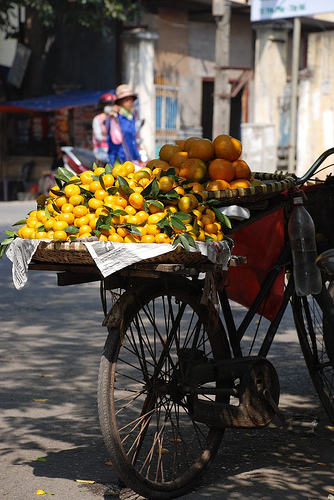 |
 |
 |
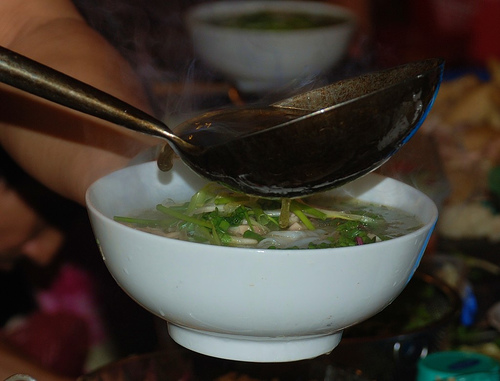 |
| A bowl of Pho |
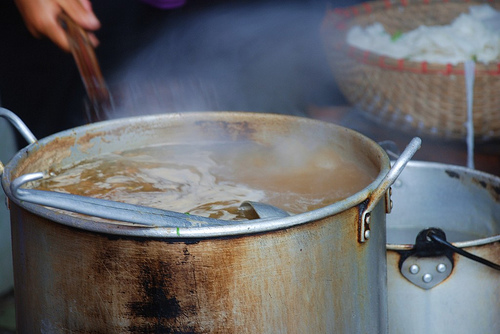 |
| Steam drifting from the simmering pot of an early morning pho seller |
|
|
| Jackfruit on the street |
|
|
| Chickens in Coke cans. |
|
|
| Preparing the meat for Bun Cha |
|
|
| Bun Cha |
I find that I have lots of moments in this city. Moments of clarity. Moments where I\'m transported to the past. Moments where a scene is truly something to behold. And then there\'s madness again and the world\'s going too fast, and Hanoi\'s spreading up and out but it\'s not like watching grass grow. I feel that if I don\'t get out the way, they\'ll be entombing me in bricks and mortar, giving me a lick of paint and setting up a teashop out front.
Before that happens and before Hanoi completes its total morphing into just another big Asian metropolis minus its distinctive wet markets and street eateries, its corners of crumbling colony, its conical hat-wearing vendors, I want to issue an invitation to anyone who\'s reading to visit and eat in Hanoi now.
I want to do that by enticing you with a run-down of Hanoi as a food destination.
I purchase sticky rice for breakfast each morning from my neighbor.
We live in a labyrinth of lanes in Nghi Tam, a sleepy district of Hanoi on the banks of West Lake. In the shadow of the Sheraton Hotel, our other neighbors concern themselves with either market gardens lined with cumquat trees or ponds and green bottles containing black fighting fish, sold in plastic bags for young men to gamble over. At 6.45am, trade in cumquat bushes and fish is slow. Sticky rice trade is brisk.
From a round bamboo basket covered in woven rattan mats, she digs a bowlful out, places it on a sheet of clear plastic, spoons on a mix of crushed peanut, sesame seed and salt before wrapping my morning meal in a page of some student’s homework. In years gone by, it would have been a banana leaf. The homework or an old electricity bill is other-worldly enough for me. Hanoi’s food culture is intriguing in unusual respects, even after eight years of residency here.
I still bike the streets with wonder at the pervasive nature of food in this city. At any moment, at least one sense is being somehow subtly seduced. It may be a vision of a pineapple seller fanning herself against a fading ochre wall, spiked yellow peel piled beside her. The mournful cries of ngo nong day (hot corn here) or banh bao nong day (hot steamed buns here) intimate that food is available, on two wheels and right by my front gate, mid-afternoon or close to midnight. A hefty whiff on the air seeps up and down the corridors of Hanoi’s old quarter signaling that fish sauce is being used in a cooking process. In late summer, the feel on the tongue of luscious longan flesh coming away from its shiny black marble of a pip is almost erotic.
For Hanoians, food is essentially fuel but it does dominate its fair share of conversations. A typical lunch in the capital centers around the staple: rice. In this part of the world, it is a wonder this grain does not have a capital letter. Admissions have been uttered to me, by some locals, to the effect that if they don\'t get their fill of this stuff for a few days, they feel physically sick, that something is not quite right inside.
Street fruits Jack fruit
While an afternoon nap generally follows lunch, evidenced by prostrate bodies on sidewalks, on desks in offices, on motorbike seats with legs dangling over the handle bars, behind market stalls with magazines over faces, it is not long before food comes to the fore again. Afternoons are consumed with heated bargaining over fruit. In the late summer, negotiations are barked over the stunning pink beauty of dragon fruit being sold off the backs of bicycles. In autumn, custard apples, pomelos and persimmons arrive by truck under cover of darkness at the bustling, heaving Long Bien market. They are distributed among an army of pavement pounding and pedaling street vendors in the hours before dawn. In winter, an array of citrus varieties is on offer. In this sub-tropical city, if the seasons cannot be easily detected by the weather conditions, observing the fruit rolling through the streets is an alternative method. If it’s lychees, it must be summer.
Dry shrimps Dong Xuan market.
The streets are restaurants, though, as much as they are markets. Walking on the pavements of Hanoi is simply not an option. If it is not a parked motorbike forcing a step down onto the road, it will be a curbside eatery. A million miniature maroon and blue plastic stools and tables litter the pedestrian zones of this city. Two dishes predominate amongst the exhaust fumes and chaos of the Vietnam capital’s roads, streets and narrow alleyways.
Pho, the most renowned, is a rice noodle soup, traditionally made only with beef and originally from Northern Vietnam. Even though Hanoi is just a few weeks away from its 1000th anniversary, pho\'s history is short and scantily documented, The Chinese and the French are said to have influenced this defining dish in Vietnam’s cuisine. The French occupation had much to do with the inclusion of beef in the diet, a meat probably considered extravagant by the Vietnamese at that time because of the contribution of the cow in the field. The Chinese connection can be seen in the use of noodles, ginger, star anise and clove.
Whatever its origins, the Vietnamese have well and truly taken ownership of this dish. While regional variation is rife, the most obvious differences occurring in the south where the noodles are thinner, the stock sweeter and the herbs more abundant, a pho purist would champion the simplicity of Hanoi pho: a clear, well-balanced but beefy broth, hints of ginger and spice evident but not overpowering, noodles flash dunked to perfection, a smattering of herbs and a decent mound of tai, beef cooked rare under the pour of the ladle. Hardly ever prepared at home, due to the complicated and time-consuming processes and the myriad of ingredients required, pho has evolved from what was a special weekend breakfast treat into the comfort food of a nation, available morning, noon and night.
old favourite
Hanoi’s other culinary masterpiece is bun cha. Popular as lunch fare only, every road, street and tiny rabbit warren serves up this dish somewhere along its length. Hand-fan powered plumes of smoke signal a bun cha eatery’s location. This dish is basically meat grilled over hot coals served in a dipping sauce with bun (vermicelli rice noodles) and a tangle of different herbs on the side.
The meat is pork, formed into little patties with garlic and shallots, as well as an egg, fish sauce and sugar marinade. A variation has the patties wrapped in la lot (wild betel leaf), adding a slight zest to the flavour. Pork belly is also utilized for this meal, sliced into a thick bacon-like cut, marinated in the fish sauce potion, caged up in the wire griller with the patties and fan-cooked to well-done, edged with crunchy charcoal. Herbs and noodles are dunked in the bowl of dipping sauce containing the meat feast, acting as a dressing for the greenery and a loosener for the vermicelli. This soup cum sauce consists of the usual suspects: fish sauce, rice vinegar, sugar, lime juice and water. Normally lukewarm, it can be doctored to taste with chili, garlic and pepper tableside. Bun cha is the great Vietnamese barbeque!
Numerous other Hanoi specialties mark the city’s streets, some challenging to western sensibilities and palates. Dog meat (thit cho) is the most obvious example. The traditional seven dish dog spread is reserved for special occasions at certain times of the lunar calendar to ward off bad luck and enliven virility. Pigs’ intestines (long lon) are more routine in the cuisine, enjoyed in rice porridge for breakfast or served among generous sprigs of Asian basil (rau hung que) for lunch. The dipping sauce for both of these delicacies is perhaps the most confronting ingredient in the entire cuisine. Known as mam tom, it has a potent aroma, half petrol and half fish. It is best translated as fermented shrimp sauce and, in my time in Hanoi, I’m yet to acquire the taste, even when the olfactory organ is being pinched with my fingers!
Washing the after-taste away presents no problem. Bia Hoi is draught beer served on the street, pulled direct from the keg, sometimes through a proper tap, sometimes enticed down a siphon by a quick suck of air from the beer-tender\'s lungs. It is available all over town, from big halls with huge menus to one keg stools on the pavement. After a meal of dog or intestines and mam tom, a few large tumblers will likely ease the experience into the past. A non-alcoholic alternative is sugar cane juice (mia da); a striking light green beverage extracted from the passing of sugar cane rods through a metal juicer contraption and poured over a half glass of crushed ice. In the oven-hot temperatures of a Hanoi summer, this refreshment momentarily halts the human melt.
My wonder at the epicurean experiences I’ve had in Vietnam’s capital are unlikely to halt. Long after I move on, vivid memories of steam drifting from the simmering pot of an early morning pho seller, of chili and lemongrass marinated pork skewers grilling roadside and of frighteningly tough and unyielding fruit vendors will remain.
Procuring a breakfast of sticky rice from my kindly neighbour will be remembered more as graceful ritual than base exchange.
Places to try some of the dishes mentioned:
Pho - see the Hanoi Pho Swoop for 25 different locations throughout the city
Bun Cha - 48 Pham Hong Thai, 3 Hoe Nhai, 20 Ta Hien and many other locations
Xoi (sticky rice) - Cnr. Nguyen Huu Huan & Hang Mam, Hang Hanh St (opp. Win Hotel)
Mia da (sugar cane juice) - 77 Hang Dieu
Bia Hoi - 118 Giang Vo, many other locations including notorious \'bia hoi corner\'


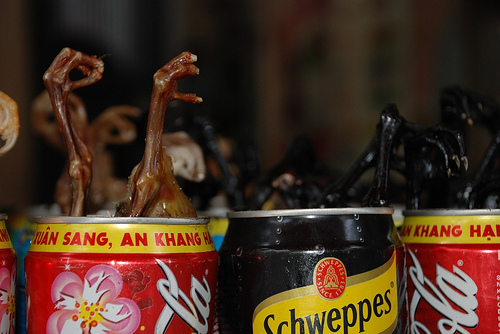

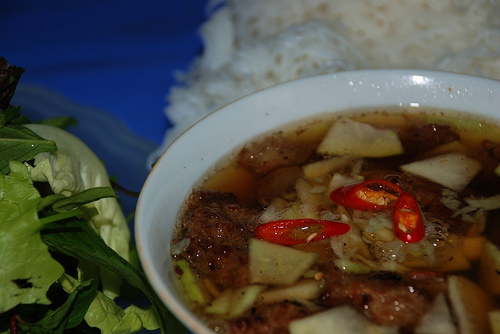
Leave your comment on this story